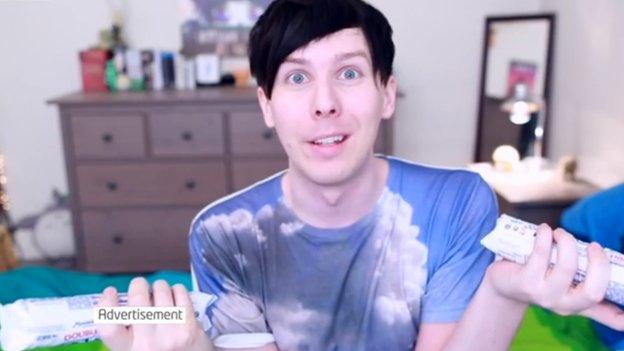Vlogger guidelines published by advertising committee
- Published

Vloggers promoting Oreo biscuits were criticised by the Advertising Standards Authority (ASA) last year
New guidelines for video bloggers who enter marketing relationships with brands have been published.
The rules encourage "vloggers" to label advertising content and explain when they have been asked to feature products sent to them by companies.
The Committee of Advertising Practice (Cap) has issued its first guidance since a landmark Advertising Standards Authority (ASA) ruling last year.
The ASA said several vlogs praising Oreo biscuits were not clearly marked.
The ruling was originally sparked by a BBC Newsround report into vloggers' lack of clarity on advertising rules.
The Cap guidelines discuss several scenarios, external in which text clarifying that content is sponsored, or that a product placement arrangement is in place, might be added to videos.
Vlogger Luke was not paid for this clip but welcomes new guidance on advertising
"A key rule under the Cap code is that if the content is controlled by the marketer, not the vlogger, and is written in exchange for payment (which could be a monetary payment or free items) then it is an advertisement feature and must be labelled as such," it says.
Viewer trust
Cap also advises brands collaborating directly with vloggers to be equally clear that the resulting content is a form of online marketing.
Similarly, vloggers advertising their own products need to make viewers aware of this before they begin watching, via the title of the video.
In a statement, Shahriar Coupal, director of Cap, said: "Wherever ads appear we should be confident we can trust what an advertiser says; it's simply not fair if we're being advertised to and are not made aware of that fact."
However, the guidelines noted that when free items are sent to vloggers without any editorial or content control over videos exerted by the brand in question, there is no need for them to follow the Cap code.
Vloggers warned over unclear adverts
Those calling for greater clarity on the issue have welcomed the move.
Riyad Barmania, at vlogger talent company ChannelFlip said that ever since the Advertising Standards Authority's (ASA) ruling against vlogs celebrating Oreo biscuits, external, his company has been working with the authority to check that content meets current guidelines.
"It's been difficult speaking to YouTube creators not to have some official guidelines," he said. "It's great to have that clarity."
He added that vloggers are, generally, quickly becoming more aware of the rules.
"A lot of YouTube creators are much more savvy and aware of branded content rules than they were a few years ago," he explained.
Co-editor of online vlogger magazine TenEightyMagazine.com Alex Brinnand says vloggers will probably benefit from the clarifications.
"I definitely feel there should be a clearer message given to users," he said. "They're not sure where these rules are coming from and who's policing them.
"If YouTubers are doing it wrong it's because they don't know better."
Vlogger influence
The influence of today's vloggers hasn't gone unnoticed.
They are increasingly viewed as role models by teenagers, according to Your Life, a government-backed campaign encouraging young people to choose maths and physics at A-level.
Nearly a quarter of 11 to 19-year-old girls (24%) view well-known fashion and beauty vlogger Zoella as a role model, according to a recent report published by the group.
"Because YouTube is part video distribution platform and part social network, it allows viewers at home to feel very close to the personalities they watch," said Jonathan Davenport, digital content consultant for Your Life, in a statement.
"As a result, YouTube is now the biggest platform for teenagers, which is why anyone with a message for a teenage audience must address them on YouTube."
- Published19 August 2015

- Published26 November 2014

- Published26 November 2014

- Published2 February 2015
